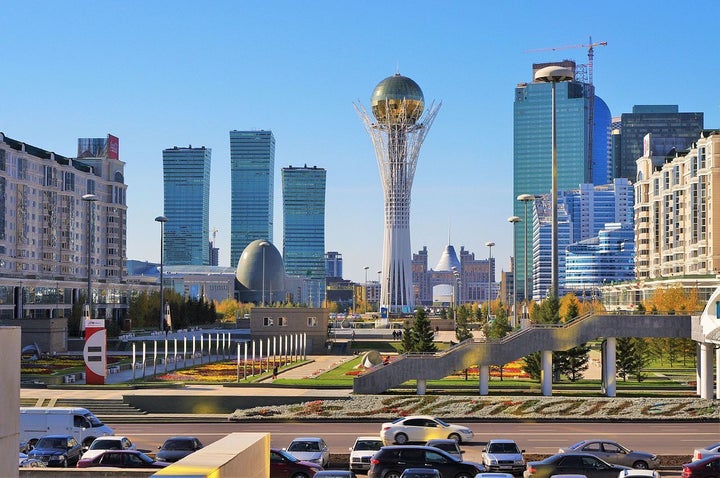
Downtown Astana, Kazakhstan
Kazakhstan made it in the news this week. After spending 115 days at the International Space Station, three astronauts—including the American Kathleen Rubins—landed safely on the steppes of the Central Eurasian country.
Aside from events, Kazakhstan rarely gets the attention of U.S. media. Even worse, meaningful focus on the region by U.S. policy makers is almost nonexistent.
Such geopolitical neglect is shortsighted.
Kazakhstan is important in regard to many of the challenges facing the U.S.: nuclear proliferation, a resurgent Russia and rising China, Islamic extremism and competition for energy resources.
A land-locked country in the middle of Eurasia, Kazakhstan is the ninth largest nation in the world. This year marks its 25th anniversary of independence from the Soviet Union.
Though Kazakhstan is a founding member of the Moscow – led Eurasian Economic Union, it has developed a foreign policy that tries to be distinct from Russia’s..
Kazakhs are very proud of their nation’s strong commitment to the non-proliferation of nuclear weapons—a firm policy since it regained independence. One rarely reads anything about the recent history of Kazakhstan, or attends a conference with Kazak officials speaking, without this commitment being mentioned—and for good reason.
Kazakhstan suffered dearly from Soviet nuclear testing. During Soviet times, 456 nuclear blasts were set off at the Semipalatinsk nuclear testing site. The last test came as recently as 1989.
During the decades of nuclear testing, little regard was paid to how this would affect the local population’s health. Such “inconveniences” were rarely a factor worth considering for the Soviet authorities in Moscow.
The testing site was vast—roughly the size of Connecticut and Rhode Island put together— so many people were affected. While the exact number is unknown, it is estimated that as many as 200,000 people living in the testing area suffered radiation exposure, including exposure’s consequences like cancer, over the years.
To rid itself of this Soviet legacy, Kazakhstan committed to removing all nuclear weapons from its territory immediately upon regaining its independence. Indeed, even before formally declaring independence, Kazakhstan had already forced the closure of the Semipalatinsk nuclear testing site.
Still, the Kazakhs had a lot of work to do. On Dec. 16, 1991, the newly independent state had 1,410 Soviet strategic and tactical nuclear warheads located on its territory. By April 1995, all of these weapons had been returned to the Russian Federation.
In 2009, Kazakhstan and its four neighbors—Kyrgyzstan, Uzbekistan, Turkmenistan and Tajikistan—established the Central Asian Nuclear Weapons Free Zone (CANWFZ). Since then, Kazakhstan has been a leader of the global non-proliferation movement. Having been one of the few countries to actually give up its nuclear weapons, it speaks with tremendous credibility on the issue—such as when it has called for Iran not to develop nuclear weapons.
With the threats posed from North Korean nukes, and a potentially nuclear armed Iran (should the shaky Iran deal collapse), Kazakhstan’s voice on the world stage now is more important than ever. Moreover, starting in January 2017 Kazakhstan will serve a term as a non-permanent member of the U.N. Security Council, where its authority will extend beyond non-proliferation issues.
The country also provides crucial energy resources to some of America’s closest allies, especially in Europe. Its supergiant Kashagan field finally came online this year—a development that could significantly reduce Europe’s energy dependency on Russia. This has tremendous security implications for the West.
Kazakhstan already is one of the top suppliers of Israel’s energy needs. Small wonder, then, that Israeli Prime Minister Benjamin Netanyahu is visiting Astana within the next three months. Kazakhstan is one of the world’s largest producers of uranium. It is creating a low- enriched uranium fuel bank for civilian nuclear energy needs.
Soon after the collapse of the Soviet Union, the U.S. seemed eager to engage with the newly independent countries like Kazakhstan. This was especially true in light of the energy opportunities emerging from the region. But by the late 2000s, the U.S. had lost much of its enthusiasm for engagement as the Afghan war wound down.
This needs to change.
The U.S. needs to develop an engagement strategy that promotes economic freedom, secures transit and production zones, develops energy resources, and counters the anti-Western consequences of the rising influence of Russia, Iran, and China in Central Eurasia.
The Central Asia region has been, is, and will continue to be an area of geopolitical importance for the U.S. At the heart of this region is Kazakhstan and, by definition, a country in the heart of Eurasia is important. If the next U.S. President is to have a grand strategy to deal with a resurgent Russia and an emboldened China, promote non-proliferation, confront transnational Islamist terrorism, and to improve Europe’s energy security, he or she cannot ignore Kazakhstan.